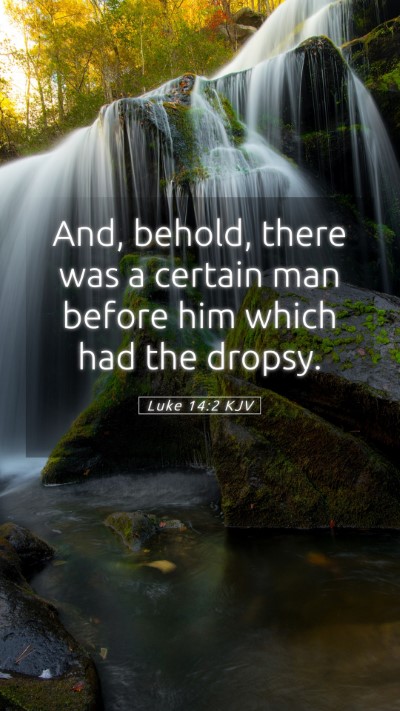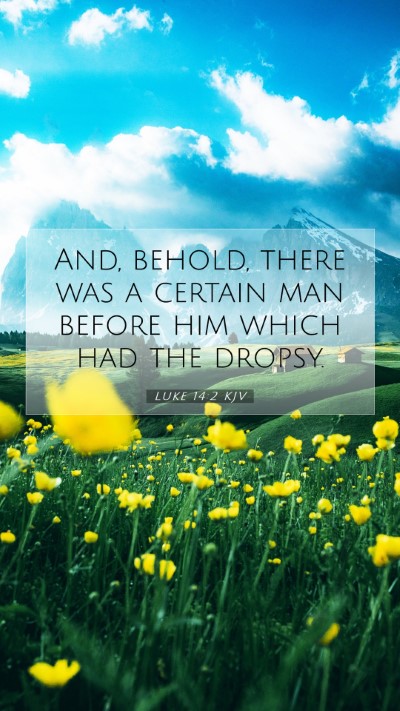Understanding Luke 14:2: A Deep Dive into Biblical Insight
Luke 14:2 states: "And behold, there was a certain man before him which had the dropsy." This verse holds significant meaning within the context of Jesus’ teachings and actions, reflecting deeper themes of compassion, the Sabbath, and the nature of service.
Contextual Overview
The setting of this verse is crucial for understanding its significance. Jesus is dining at the house of a prominent Pharisee, which indicates the social and religious context of the time. The presence of a man with dropsy—an illness characterized by an abnormal accumulation of fluid in the body—raises critical questions about the laws of the Sabbath and the notion of healing.
Commentary Insights
- Matthew Henry highlights the importance of the setting, noting that Jesus' presence at the Pharisee's house serves as a backdrop for the controversy concerning the healing on the Sabbath. He suggests that this encounter illustrates Jesus’ authority to challenge prevailing Jewish customs regarding the observance of the law.
- Albert Barnes points out that the man with dropsy is intentionally presented to emphasize the compassion of Christ. This situation serves to manifest Jesus’ willingness to reach out to those marginalized by society. Barnes notes that Jesus’ actions depict the heart of His ministry, prioritizing mercy over ritualistic observance.
- Adam Clarke provides an historical perspective, exploring the societal repercussions faced by individuals with illnesses in biblical times. He emphasizes that the dropsy was a condition that not only had physical implications but also social stigmas. This context enriches our understanding of Jesus’ healing and compassion, emphasizing His role as a healer in a judgmental society.
Thematic Elements
There are several key themes tied to this verse that contribute to broader biblical teachings:
- Compassion and Mercy: The presence of the afflicted man serves as a reminder of the compassion that Jesus embodied throughout His ministry. His willingness to heal on the Sabbath demonstrates that love transcends legalism.
- Challenge to Tradition: Jesus frequently challenged traditional interpretations of the law, emphasizing that the spirit of the law—focused on love and mercy—should prevail over legalistic adherence.
- Social Inclusion: The act of healing not only restores the man physically but also socially. It symbolizes Jesus' mission to include the marginalized and promote a community based on love rather than exclusion.
Historical Context
In Jewish tradition, the Sabbath is a day of rest, where work is prohibited. Jesus’ act of healing the man with dropsy raises questions about what constitutes work. It serves as a point of contention with the Pharisees, who held stringent views on Sabbath observance. Understanding this historical context allows for a deeper interpretation of not only this verse but also the broader implications of Jesus' teachings about the law.
Application in Daily Life
The lessons drawn from Luke 14:2 resonate in today's context. Believers are encouraged to reflect on the following:
- How do we prioritize compassion and mercy in our own lives, especially concerning societal norms?
- In what ways can we challenge legalistic interpretations of our beliefs to focus on love?
- How can we ensure that those who are marginalized in our communities feel included and valued?
Cross References
To further explore the themes present in Luke 14:2, consider the following related verses:
- Matthew 12:10-13: Jesus heals a man with a withered hand, again challenging Sabbath laws.
- Mark 3:1-5: Another account of healing on the Sabbath, emphasizing Jesus' approach to the law.
- Luke 13:10-17: Jesus heals a woman afflicted for eighteen years on the Sabbath, showcasing His compassion.
Concluding Thoughts
Luke 14:2 reflects not only a miraculous healing but also challenges us to consider the essence of Jesus’ teachings. It calls us to embody the principles of compassion, challenge legalism, and strive for inclusivity in our communities. As we ponder this verse, we gain insights that are applicable both in personal reflection and communal engagement.
Further Resources
For those interested in a deeper understanding, consider participating in Bible study groups or utilizing Bible study tools available online. Engaging with others in online Bible study can also facilitate rich discussions around such passages.
“What does Luke 14:2 mean?” - This fundamental question invites an exploration of compassion, service, and the interpretation of Scripture.


